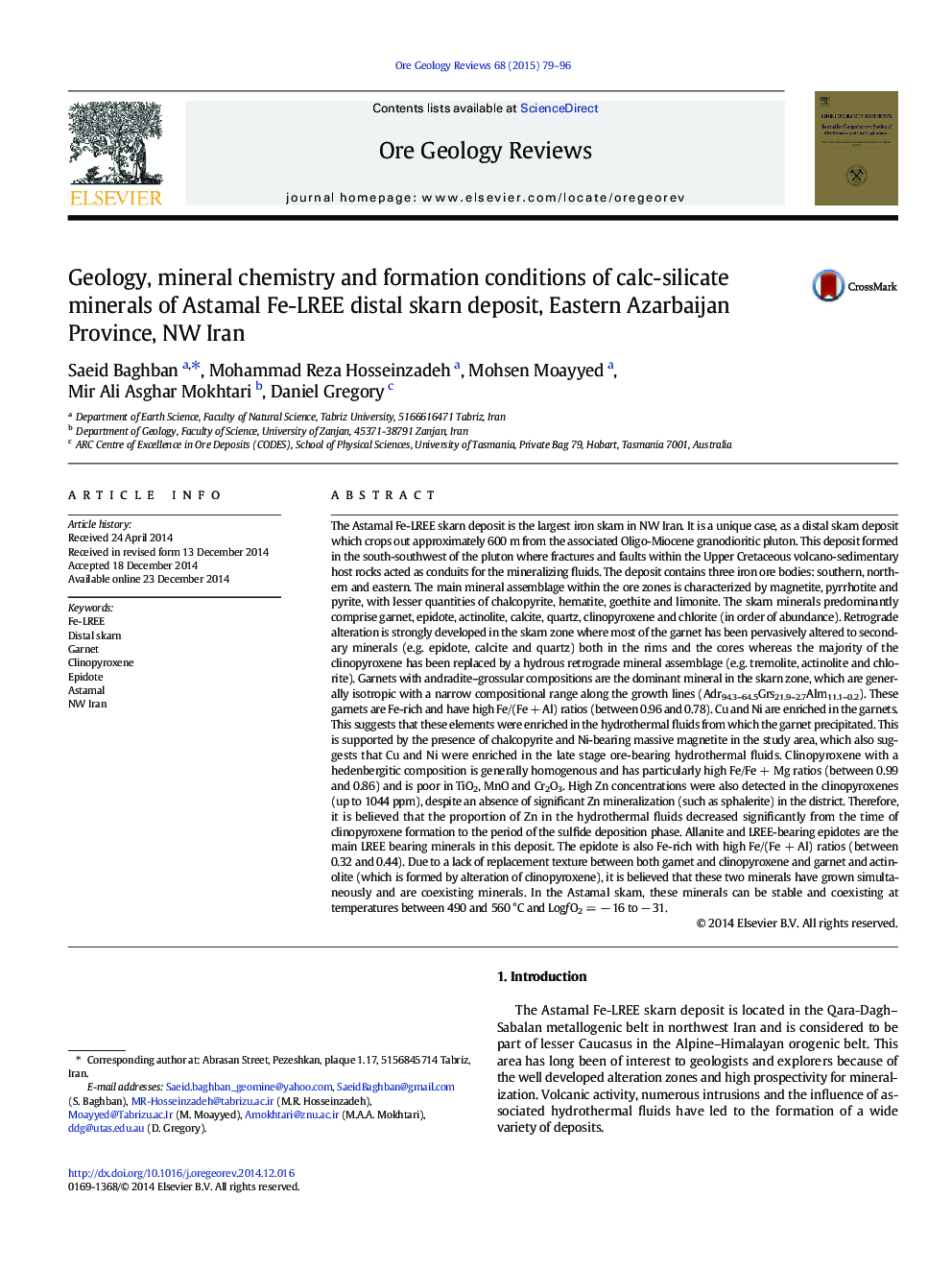| کد مقاله | کد نشریه | سال انتشار | مقاله انگلیسی | نسخه تمام متن |
|---|---|---|---|---|
| 4697349 | 1637236 | 2015 | 18 صفحه PDF | دانلود رایگان |

• The Astamal skarn occurred approximately 600 m from the associated batholith.
• LREE mineralization occurred in LREE-bearing epidote and allanite, and is found both in the skarn and the Fe ore zones.
• The garnets and the clinopyroxenes have a narrow compositional range along the growth lines and are coexisting.
The Astamal Fe-LREE skarn deposit is the largest iron skarn in NW Iran. It is a unique case, as a distal skarn deposit which crops out approximately 600 m from the associated Oligo-Miocene granodioritic pluton. This deposit formed in the south-southwest of the pluton where fractures and faults within the Upper Cretaceous volcano-sedimentary host rocks acted as conduits for the mineralizing fluids. The deposit contains three iron ore bodies: southern, northern and eastern. The main mineral assemblage within the ore zones is characterized by magnetite, pyrrhotite and pyrite, with lesser quantities of chalcopyrite, hematite, goethite and limonite. The skarn minerals predominantly comprise garnet, epidote, actinolite, calcite, quartz, clinopyroxene and chlorite (in order of abundance). Retrograde alteration is strongly developed in the skarn zone where most of the garnet has been pervasively altered to secondary minerals (e.g. epidote, calcite and quartz) both in the rims and the cores whereas the majority of the clinopyroxene has been replaced by a hydrous retrograde mineral assemblage (e.g. tremolite, actinolite and chlorite). Garnets with andradite–grossular compositions are the dominant mineral in the skarn zone, which are generally isotropic with a narrow compositional range along the growth lines (Adr94.3–64.5Grs21.9–2.7Alm11.1–0.2). These garnets are Fe-rich and have high Fe/(Fe + Al) ratios (between 0.96 and 0.78). Cu and Ni are enriched in the garnets. This suggests that these elements were enriched in the hydrothermal fluids from which the garnet precipitated. This is supported by the presence of chalcopyrite and Ni-bearing massive magnetite in the study area, which also suggests that Cu and Ni were enriched in the late stage ore-bearing hydrothermal fluids. Clinopyroxene with a hedenbergitic composition is generally homogenous and has particularly high Fe/Fe + Mg ratios (between 0.99 and 0.86) and is poor in TiO2, MnO and Cr2O3. High Zn concentrations were also detected in the clinopyroxenes (up to 1044 ppm), despite an absence of significant Zn mineralization (such as sphalerite) in the district. Therefore, it is believed that the proportion of Zn in the hydrothermal fluids decreased significantly from the time of clinopyroxene formation to the period of the sulfide deposition phase. Allanite and LREE-bearing epidotes are the main LREE bearing minerals in this deposit. The epidote is also Fe-rich with high Fe/(Fe + Al) ratios (between 0.32 and 0.44). Due to a lack of replacement texture between both garnet and clinopyroxene and garnet and actinolite (which is formed by alteration of clinopyroxene), it is believed that these two minerals have grown simultaneously and are coexisting minerals. In the Astamal skarn, these minerals can be stable and coexisting at temperatures between 490 and 560 °C and LogƒO2 = − 16 to − 31.
Journal: Ore Geology Reviews - Volume 68, July 2015, Pages 79–96